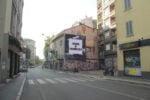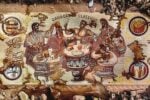Andrea Kvas – Staring Contest
 (320x480).jpg)
Mostra personale
Comunicato stampa
Courtesy of Jacopo Menzani - M studio
Ermes-Ermes is pleased to present
Andrea Kvas
Staring Contest
November 13 - December 11
opening Friday, November 13
7 - 9.30 pm
Burggasse 24
1070 Vienna, Austria
Text by Cecilia Canziani
I wish I had visited Andrea’s studio before writing this text. Studios, especially for painters who, amongst all artists, are those who develop a more necessary relationship with their work space, always tell a lot about who inhabits them. You could tell a history of art through the representations of the artist’s studio (in fact, Svetlana Alpers partially did it).
Friedrich’s studio was monastic, completely empty except for a square ruler hanging from a nail, an easel and a canvas which the artist was painting placed next to a large window – even his colours were in another room in order to avoid affecting the view.
Francis Bacon’s studio: full of canvases, drawings, notes, colours, brushes: almost impassable. Duchamp’s studio, in the period when the artist pretended to quit making art, also perfectly matched his latest work.
Helen Chadwick who, despite not owning a proper one, kept working in the kitchen and the bathroom and made her home coincide with the studio, turning it into a key theme in her work.
Philip Guston’s studio, without lighting facilities because the artist could only paint in darkness.
The studio represents a place in which the image incarnates, as evoked by details in Picasso’s Guernica – the axes on the floor and the lamp on the ceiling - and in Courbet’s Atelier, in which it accommodates an image of the people, in Vermeer’s paintings (all of them) and Andy Warhol’s Factory portraits.
I liked the idea of visiting him in his studio, also because Andrea Kvas lives in a peripheral place, a village close to Udine where he landed after his studies in Venice, a residency at the Bevilacqua La Masa foundation and six months in Milan which were enough for him to realize that he could not work there. Many are the Italian artists who don’t live in Milan, nor in Turin, neither in Rome or in the main city of their region.
This geography deprived of centers seemed to me to reflect what the country was and still is, and the richness these places still transmit, the way they mingle into the artists’ work.
To Andrea, there was a connection with this place: there his mother had worked and everybody knew him. His studio is adjacent to his house. Thus, there is nothing more than a door to divide the two phases of the day, in a way that he often goes to sleep still wearing the work of the day, as he once told me. I especially liked this expression.
The studio, for its dimension, its light conditions, the proximity to other places, always determines the work. The big canvas on show in this exhibition, for instance, has been reworked through several phases until the moment it was finished, due to space reasons. Andrea didn’t conceive it in its entirety. After being folded, it was painted with shellac and was inserted on a frame smaller than its surface and the exceeding fabric was left free, overabundant. This framed surface was painted with two shades of red, one more tenuous and opaque, the other darker and shiny only partially covered the shellac drippings. The thick border (conceived following the same excess, as the overabundant canvas, since the frame was built with 5 centimetres wooden beams) was painted in two different shades of yellow that corresponded to the two shades of red: one paler, the other shinier and saturated. Once the colour dried, the canvas was removed by the frame and hung on the wall with two nautical grommets attached to the corners. Also in this case, the work is disproportionate compared to the studio space.
As a consequence, we perceive a boosted effect of what in Andrea’s paintings is always present: an ambiguity between painting and sculpture, or a possibility for the painting to position itself in space as an object, since its surface is always painted on all sides. The pigment is emulsified with the ties which, once dried, stretch it stiff and allow to maintain the folds and the volumes that are impressed on it (together with ash, dust and all the other the accidents and events connected to the making of it).
Painted horizontally, often the canvas has no direction and its shape is partially built according to a project, partially according to chance, because it was constructed in portions. Once finished, often the position it occupies is not permanent and there is always a hint of the possibility of its reversibility, of a potential return to its horizontal inception, or the reverse, or the fold.
Thus, Andrea’s research clarifies itself as a survey on the problems of painting and is reinstated in an apparently casual shape, as if it was created distractedly or by excess. In the same way, right after painting this sort of great sail that invades the space of his studio, he painted a slightly different double: whose central square appears to be crooked, its surface is painted with a hardware store-like brown which covers and hides the inferior layers and where the shellac is denser and darker because, during the time between its preparation and the realization of both canvases, the alcohol evaporated leaving a denser colour. This is a reaction to the topos of the absolute, of the masterpiece, of the unicum. Besides, the use of carpentry and hardware store colours, of construction materials, glues, resins and pigments emulsified with water based colours, and enamels forces the canvas to a processual quality whereby no artwork is really finished because the chemical relations between the different materials that compose the pictorial surface are all about-to-become and totally unpredictable.
I don’t know – and I assume Andrea doesn’t know either – which one of the two canvases will be exhibited. But the fact of having realised a different twin of the painting which was originally conceived for the space highlights the fact that also the other works which have been exhibited in Vienna, both untitled (respectively from 2015, and 2014-15), don’t exist beyond the relationship between two elements.
The first untitled (2015) is a double sided print on paper of the same image mirrored on both sides, and then treated with epoxy resin to makes it stiff and shiny.
The slight shift between the two images records the shift between painting and photography: from artwork to documentation and back to artwork. (The photos of this work that Andrea sent me show both sides, and I like the idea that the work is set against two different backgrounds: the studio interior, which I recognize by its details, and the landscape out of which it looks, crossed by a thin and solitary bell tower typical of this part of Italy).
The other untitled (2014-15) is an object composed by two surfaces of different materials and qualities which sustain each other. One is a wooden board painted with spray colours, mixed media and pigmented shellac, shiny and reflective. It was originally realised for an exhibition and adapted to a space from which it couldn’t be extracted in any way but by being torn into pieces. The board, so spitefully cut, was left inert for a long time and was then carved without any intention of turning it into a specific artwork. Its shape was determined by an improvisational exercise concerning the theme of the “bend cut”, a consequence of the enthusiasm for the purchase of a new jigsaw. It was only when it was juxtaposed to the other shape - a polyurethane cast on canvas with applied pigments and shellac – that it assumed precisely the shape of an artwork element (it takes two to tango).
It reminds me of the artwork’s dimension of potential and transformation typical of the studio space. Often it’s staged, but it can also be transported in the exhibition space.
Indeed, I haven’t seen Andrea’s studio, but I’ve seen him working several times for exhibitions which took shape in the museum space and transformed it into a temporary studio space. Besides, his works are often completed with a final, in situ intervention and the variables imposed by the space come thus to coincide with the physical limits of the studio space, which force him to work in a state of partially uncontrolled planning. Finally, by leaving the exhibition space in order to go back to the studio space, frequently a change of status takes place: a suspension of judgement thanks to which the artwork gets back to its material state in order to start a new generative cycle.
A text by Georgers Didi-Huberman came back to my memory over the last few days, while I was writing about Andrea’s work. It takes inspiration from the observation of the inferior register of a cycle of frescos by Fra Angelico in the convent of San Marco in Florence. These are four, almost monochrome square frames sprinkled by pigments. This portion of service painting that, by its nature, was never analyzed by art historians, on the contrary is exactly the place in which we realise the contemporaneity of the painter. Due to the immediacy of the gesture that he operated on the surface, he gave a sort of anticipation of the space as a place for painting as action. The word that the philosopher uses to describe this spaces of painting removed from the gaze of the historian is parergon.
Sometimes images resonate for a reason, and to me it seems that Andrea’s work can also be read as a poetics of the residue, of the leftover, of the margins. Of what is accessory, too, as the invitation for this exhibition testifies: a mysterious image, a creature of the abyss or a gaseous formation from the depths of the galaxy. Indeed, the infinite space that surrounds the stringy figure is a shiny board painted with shellac on which the casual fall of a reflex camera caused a slight damage, the small figure that inhabits the photo.
Events leave traces and transform things: those that later on, sometimes, happen to be found in front of our gaze and become artworks.
Andrea Kvas (b. 1986) lives and works in Percoto. Recent solo exhibitions: in 2015 Andrea Kvas e Nicola Martini, Kaufmann Repetto, Milan; in 2014 Atacai, CO2 gallery, Turin; in 2013 Boy with Bucket, Chert, Berlin; Campo, Marino Marini Museum, Florence; in 2011 Sisyphe, Cripta 747, Turin; Ogni cosa a suo tempo, with Adrian Paci, Basilica di Santa Maria Maggiore, Bergamo. Recent group exhibitions: in 2014 Ab-Stretching the Canvas, Jeanine Hofland, Amsterdam; Dizionario di Pittura, Francesca Minini, Milan; Ah, si va a oriente!, Fondazione per l’Arte, Rome; in 2013 The Time Machine (The Survivors), CURA.Basement at Frutta Gallery, Rome; in 2012 I’ll explain you everythiinnngggg, Chert, Berlin; in 2011 segalega, ZERO…, Milan.



